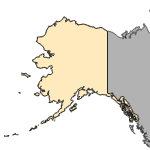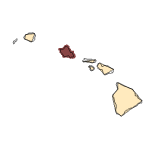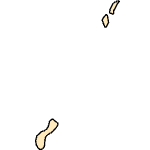Pelvicachromis pulcher
(rainbow krib)
Fishes
Exotic |
|
Common name: rainbow krib
Synonyms and Other Names: kribensis, common krib, pink krib, rainbow cichlid, pelvicachromis
Taxonomy: available through
www.itis.gov
Identification: Another commonly used name is Pelmatochromis pulcher. Many color varieties of P. pulcher are common in the aquarium trade (Axelrod 1993). Color photographs were given in Axelrod et al. (1985) and in Axelrod (1993). The genera of pelmatochromine fishes were reviewed by Greenwood (1987).
Size: 10 cm (Petrovicky 1988).
Native Range: Tropical Africa. Western Africa; types from Niger delta, Nigeria (Axelrod 1993).



|

Alaska |

Hawaii |

Puerto Rico &
Virgin Islands |

Guam Saipan |
Hydrologic Unit Codes (HUCs) Explained
Interactive maps: Point Distribution Maps
Nonindigenous Occurrences:
Table 1. States with nonindigenous occurrences, the earliest and latest observations in each state, and the tally and names of HUCs with observations†. Names and dates are hyperlinked to their relevant specimen records. The list of references for all nonindigenous occurrences of Pelvicachromis pulcher are found here.
Table last updated 1/15/2026
† Populations may not be currently present.
Means of Introduction: Aquarium escape (Devick 1991b), accidental introduction (Devick 1991a).
Status: Established in Hawaii.
Impact of Introduction: The impacts of this species are currently unknown, as no studies have been done to determine how it has affected ecosystems in the invaded range. The absence of data does not equate to lack of effects. It does, however, mean that research is required to evaluate effects before conclusions can be made.
References: (click for full references)
Axelrod, H. R. 1993. The most complete colored lexicon of cichlids. Tropical Fish Hobbyist Publications, Inc., Neptune City, NJ.
Axelrod, H. R., W. E. Burgess, N. Pronek, and J. G. Walls. 1985. Dr. Axelrod's atlas of freshwater aquarium fishes. Tropical Fish Hobbyist Publications, Inc., Neptune City, NJ.
Devick, W. S. 1991a. Disturbances and fluctuations in the Wahiawa Reservoir ecosystem. Project F-14-R-15, Job 4, Study I. Division of Aquatic Resources, Hawaii Department of Land and Natural Resources. 21 pp.
Greenwood, P. H. 1987. The genera of pelmatochromine fishes (Teleostei, Cichlidae): a phylogenetic review. Bulletin of the British Museum (Natural History) Zoology 53(3):139-203.
Petrovicky, I. 1988. Aquarium fish of the world. Hamlyn, London, England.
Author:
Nico, L.
Revision Date: 12/6/1999
Peer Review Date: 12/6/1999
Citation Information:
Nico, L., 2026, Pelvicachromis pulcher (Boulenger, 1901): U.S. Geological Survey, Nonindigenous Aquatic Species Database, Gainesville, FL, https://nas.er.usgs.gov/queries/FactSheet.aspx?speciesID=472, Revision Date: 12/6/1999, Peer Review Date: 12/6/1999, Access Date: 1/15/2026
This information is preliminary or provisional and is subject to revision. It is being provided to meet the need for timely best science. The information has not received final approval by the U.S. Geological Survey (USGS) and is provided on the condition that neither the USGS nor the U.S. Government shall be held liable for any damages resulting from the authorized or unauthorized use of the information.